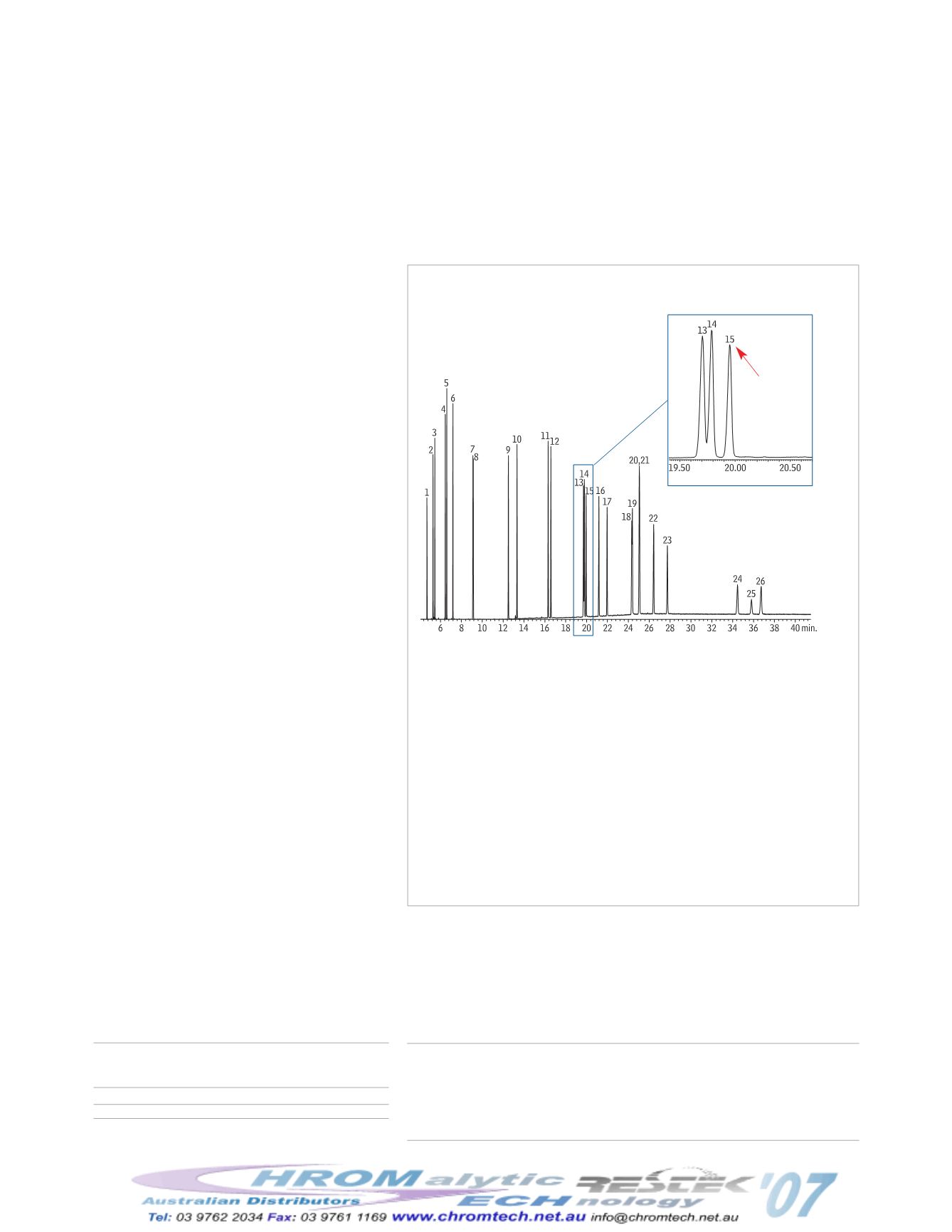

Figure 1
Fast, effective separation of target PAHs using an Rxi™-17
column and an optimized temperature program.
•
10
•
2007 vol. 3
Resolving the Benzo(j)fluoranthene Challenge
Separate New PAHs Quickly Using the Rxi™-17 GC Column
By Robert Freeman, Environmental Innovations Chemist
• Fully resolve benzo(j)fluoranthene from benzo(b) & (k).
• Excellent resolution of 16 priority pollutant PAHs.
• Separate difficult dibenzo pyrene isomers.
New Compounds, New Challenges
Polynuclear aromatic hydrocarbons (PAHs) are
widespread organic pollutants that significantly
affect environmental quality and raise human
health concerns. The US EPA mandates testing of
16 priority PAH pollutants, while analyte lists in
other countries are expanding to include com-
pounds such as benzo(j)fluoranthene, dibenzo(a,h)-
acridine, and dibenzo(a,e)pyrene, that are difficult
to analyze under conventional test conditions.
Benzo(j)fluoranthene and benzo(b)fluoranthene,
for example, co-elute on a 5%diphenyl/95%dimethyl
polysiloxane stationary phase. When reporting of
individual concentrations for each isomer is
required, conventional methods are not viable and
new solutions must be found.
The Rxi™ Alternative
The Rxi™-17 column contains a 50% diphenyl/50%
dimethyl polysiloxane stationary phase. The higher
concentration of phenyl groups in this stationary
phase increases retention of phenyl-containing
compounds, such as PAHs, thus facilitating sepa-
ration. We also used a Drilled Uniliner
®
inlet liner
since it eliminates sample exposure to cold spots
and potentially active metal components in the
injection port. Using a pulsed splitless injection,
we maximize sample transfer to the column while
minimizing high molecular weight discrimination.
The data in Figure 1 demonstrate the excellent
resolution of benzo(j)fluoranthene achievable
on the Rxi™-17 column. Phenanthrene and
anthracene also resolve well on this column under
slower run conditions (data not shown). Using the
Rxi™-17 column with an optimized temperature
program is a practical solution to the challenges
posed by expanding PAH analyte lists. If you are
struggling to quantify PAHs on conventional
columns, try the Rxi™-17 column and the opti-
mized temperature program shown here.
Rxi™-17 Columns (fused silica)
(Crossbond
®
50% diphenyl / 50% dimethyl polysiloxane)
ID df (µm)
temp. limits
length cat. #
price
0.25mm 0.25 40 to 280/300°C 30-Meter 13523
$420
acenaphthene
acenaphthylene
anthracene
benzo(a)anthracene
benzo(a)pyrene
benzo(b)fluoranthene
benzo(k)fluoranthene
benzo(ghi)perylene
chrysene
dibenzo(a,h)anthracene
fluoranthene
fluorene
indeno(1,2,3-cd)pyrene
naphthalene
phenanthrene
pyrene
SV Calibration Mix #5 / 610 PAH Mix
(16 components)
2,000µg/mL each in methylene chloride, 1mL/ampul
cat. # 31011
(ea.) $81
benzo(j)fluoranthene
dibenzo(a,h)acridine
dibenzo(a,j)acridine
7H-dibenzo(c,g)carbazole
dibenzo(a,e)pyrene
dibenzo(a,h)pyrene
dibenzo(a,i)pyrene
3-methylcholanthrene
PAH Supplement Mix for Method 8100
(8 components)
1000µg/mL each in methylene chloride, 1mL/ampul
cat. # 31857
(ea.) $162
Direct Injection Liners for Agilent GCs
ID* x OD & Length (mm)
qty.
cat.#
price
Drilled Uniliner
®
(hole on top)
4.0 ID x 6.3 OD x 78.5
5-pk.
21055
£177.10
GC_EV00925
Peak List
Ret. Time (min.)
1. naphthalene
4.70
2. 1-methylnaphthalene
5.28
3. 2-methylnaphthalene
5.46
4. acenaphthylene
6.45
5. acenaphthene
6.60
6. fluorene
7.18
7. phenanthrene
9.10
8. anthracene
9.14
9. fluoranthene
12.50
10. pyrene
13.33
11. benzo(a)anthracene
16.32
12. chrysene
16.58
13. benzo(b)fluoranthene 19.70
Ret. Time (min.)
14. benzo(k)fluoranthene 19.78
15. benzo(j)fluoranthene
19.95
16. benzo(a)pyrene
21.17
17. 3-methylcholanthrene 21.97
18. dibenzo(a,h)acridine
24.33
19. dibenzo(a,j)acridine
24.39
20. indeno(1,2,3-cd)pyrene 25.04
21. dibenzo(a,h)anthracene 25.07
22. benzo(ghi)perylene
26.43
23. 7H-dibenzo(c,g)carbazole 27.75
24. dibenzo(a,e)pyrene
34.46
25. dibenzo(a,i)pyrene
35.80
26. dibenzo(a,h)pyrene
36.73
Column: Rxi™-17, 30m, 0.25mm ID, 0.25µm (cat.# 13523)
Sample: PAH mix, 20µg/mL each component: EPA Method 610 Mix (cat.# 31011), PAH Supplement Mix
(cat.# 31857), 1-methylnaphthalene (cat#31283), 2-methylnaphthalene (cat#31285); Inj.: 1.0µL pulsed splitless
injection (20ng each component on column), 4mm Drilled Uniliner
®
inlet liner with hole at top (cat # 21055);
pulse: 20psi @ 0.3 min., 40mL/min. @ 0.2 min. Inj. temp.: 300°C; Carrier gas: helium, constant flow; Flow
rate: 1.2mL/min.; Oven temp.: 90°C (hold 1.0 min.) to 215°C @ 25°C/min. (hold 0.5 min.) to 235°C @ 4°C/min.,
to 280°C @ 15°C/min., to 320°C @ 4°C/min. (hold 20 min.); Det.: Agilent 5973 GC/MS; Scan range: 50-550 amu;
Solvent delay: 4.0 min.;Tune: DFTPP; Ionization: EI
benzo(j)
fully
resolved!











